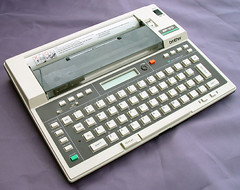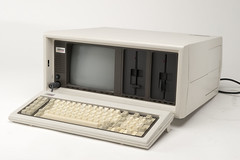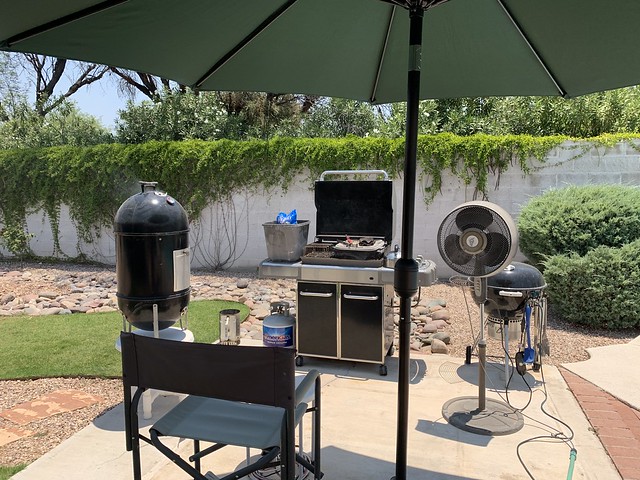A friend and I were recently talking about how we came to computers. I didn’t want anything to do with personal computers when they started coming into use, and remember the stupid and condescending thing I said when my fighter squadron in Alaska first installed a desktop computer and printer in the pilot lounge for us to use: “That’s what 702s are for.” Which was Air Force speak for admin troops.
 That was in 1983. Within a year my father, which whom I exchanged long typewritten letters at least twice a month, started using one of the early word processing electric typewriters. He loved it and talked me into getting one too. Those devices introduced a lot of people to computer functions we’d later come to take for granted: typing documents into memory and editing them before printing, scrolling from paragraph to paragraph in a small text window above the keys. They had built-in spell checkers, and — first time I’d ever heard of such a thing — a cut & paste function which allowed you to move sentences and even entire paragraphs around. I was instantly hooked.
That was in 1983. Within a year my father, which whom I exchanged long typewritten letters at least twice a month, started using one of the early word processing electric typewriters. He loved it and talked me into getting one too. Those devices introduced a lot of people to computer functions we’d later come to take for granted: typing documents into memory and editing them before printing, scrolling from paragraph to paragraph in a small text window above the keys. They had built-in spell checkers, and — first time I’d ever heard of such a thing — a cut & paste function which allowed you to move sentences and even entire paragraphs around. I was instantly hooked.
 In 1985 the USAF sent me to Armed Forces Staff College in Norfolk, Virginia. Every officer in my seminar group was issued a portable (“luggable” was the word I remember we used) Compaq computer to carry back and forth between the classroom and our quarters. The object was to introduce new field grade officers to personal computers. You couldn’t not use it: we had to compose and write our graduation thesis on the Compaq. I remember how heavy it was and how its sharp edges would bruise my legs when I carried it by its handle. It had two 5″ floppy drives. One was for the word processing program disk (an early version of WordStar); the other was for the blank disk on which we were to write and save the thesis and bibliography. As primitive as it was, it was a quantum leap from the electric typewriter/word processor I was still using for personal correspondence, even if I did have to lug it across the quad to the schoolhouse in order to connect it to a printer.
In 1985 the USAF sent me to Armed Forces Staff College in Norfolk, Virginia. Every officer in my seminar group was issued a portable (“luggable” was the word I remember we used) Compaq computer to carry back and forth between the classroom and our quarters. The object was to introduce new field grade officers to personal computers. You couldn’t not use it: we had to compose and write our graduation thesis on the Compaq. I remember how heavy it was and how its sharp edges would bruise my legs when I carried it by its handle. It had two 5″ floppy drives. One was for the word processing program disk (an early version of WordStar); the other was for the blank disk on which we were to write and save the thesis and bibliography. As primitive as it was, it was a quantum leap from the electric typewriter/word processor I was still using for personal correspondence, even if I did have to lug it across the quad to the schoolhouse in order to connect it to a printer.
It would be another ten years before most of us learned about email and the internet. On a list of momentous developments in my lifetime, those two things will certainly place near the top.
I owe you an update on our dachshund, Mister B. He came home from the animal hospital groggy and gurgling with intravenous fluids, antibiotics, and anti-inflammatories, but has since transitioned to oral meds. His cough has come back, but it’s not as persistent as before and is getting steadily better, along with his breathing. The fever is gone. I’m concerned that he seems to get food caught in his throat, but he perks up at breakfast and dinner time and is back on his regular food again. It’s an agonizingly slow recovery, but we’re seeing small changes for the better. It’s up to Mister B now because we can’t afford another hospitalization. There are several days’ worth of oral meds still to administer, mostly antibiotics (whoever invented pill pockets deserves a Nobel). Your continued healing thoughts and wishes are welcomed!
Donna’s been working on a custom shirt pocket logo for a client. He came over yesterday afternoon to look at and approve a sample sew-out. With his partner and dog. They wound up staying for two hours. It wasn’t just a business call: we know the couple socially but haven’t seen them in two or three years.
We don’t think twice about masking up when we’re out shopping and mingling with strangers. With friends, whether they visit us or we them, masks in the home just seem rude. We did what we could to keep a polite six feet between us without looking like we were forcing the issue. Today a neighbor dropped by to help us get our new cable TV connections and remotes working, basically a bare-faced repeat of yesterday. This morning I went out for a haircut: my barber wore a mask but I couldn’t — the straps would have been in the way. It ain’t easy.
Donna asked if I wanted anything for Father’s Day and I said no, but would enjoy firing up the smoker and cooking a rack of ribs. It was indeed a fun day, made even better by a call from our son and his family. Our daughter wished me a happy Father’s Day a week early, but that’s okay, I saved and savored it anew yesterday.
As to the smoking, I tried a new, slower method of lighting the charcoal, along with a more scientific approach to regulating airflow through the smoker vents to control the temperature inside. The results were gratifying. I didn’t take a photo of the ribs, but I did take one of the grilling and smoking area, set up on our old hot tub pad:
It takes about four hours to smoke a rack of ribs. Getting the smoker set up and going takes awhile, but after that things pretty much take care of themselves. I spent a few minutes with the smoker every hour, adjusting vents and adding wood chips. Knowing it was going to get up to 105°F, I set up an outdoor misting fan to keep me cool during those visits. It helped tremendously, that and the shade from the umbrella. As you can see, I put the smoker on a stand to bring the work of tending to it up to my level. There you have it: my Fortress of Smoke™.
Happy belated Father’s Day to all you dads!

Paul,
When I was a young “Heavy Equipment Repairer” working in the “Organizational Maintenance Shop” of the Wyoming Army National Guard, in Laramie, we got a new tool. The first IBM compatible desktop computer. It used MS-DOS, pre-Windows Microsoft operating system. We had an early version of Lotus 123, a spreadsheet, and Enable, a combination word processor, spreadsheet, and simple database program. It also had a small (by today’s standard) hard drive which contained the operating system, and storage space.
This was a gigantic improvement of booting from a floppy drive, and saving to disk, any work done. My belief was that word processing was for letters and documents, spreadsheets was for processing math, and database was for tracking data, holds true today. Due to my interest, I became the primary user in the shop.
We had a requirement, at the time, of documenting all productivity, by time, of employees. The “title 32 program.” We had a “NGB-OPM’ representative assigned to our shop, whose job it was, to track all of our manhours. This individual compiled by tickmarks, our time into direct productive, and non-productive manhours (what we were doing each day). When the DOD employee left, we still had a requirement to produce a report for all hours of employees. This had several categories.
My shop chief, supervisor, did the math by hand, and produced the report. Monthly, he struggled. and would finally ask for my help. I ran all input through a spreadsheet, after building the formulas, and quickly gave the answers he needed for accuracy. This brought about the change for me, including the need for an IT guru in the shop.
I soon started work in designing a database, including all of the functions of the Army’s DD-314 (form for Scheduling and Maintaining Preventive Maintenance Service Record). The good things about the Enable program database, we that the input, screen, and output forms were totally built locally. My database included all makes and models of equipment. If the model included a specific requirement for an adjustment or lubrication point, my output form created by me, included that item, scheduled hours/miles. My output form would report only those items that had an input of “greater than blank’. So, output would only reply if data was contained.
This was produced for all pieces of equipment in our inventory. Competing with a fellow member’s Lotus spreadsheet output (which required extensive navigation) my system was quickly adopted statewide. This became the the statewide standard. I bought my first desktop PC based on the fact that I wanted to duplicate all work done in the shop, at home. Still working on MS-DOS, and Enable, I bought a home system, complete with wide-carriage dot matrix printer.
After many errors, crashing my system, and re-building it, I became an IT guru. One of the items I found was an NGB bulletin board which had downloadable products. The best of it was IBM anti-virus. It was a complete protection program, and gave you their list of viruses out there, including a complete description, how to clean, manually, an infected system, and how the virus worked.
I became the anti-virus guy for WY-ARNG. In this time, I moved from being the new shop chief in Laramie to the Maintenance Manager, for the WY-ARNG (MSG-CW2 due to loss of E8 on the MTOE, and my completion of WOBC at Fort Rucker). I did a lot of help to the state staff while in the Headquarters, regarding IT work, including virus cleanup. When our mainframe was going away (the feed to NGB) I discovered that the data feed to the Army about the reportability of end items (anything that had a US registration number vehicles and equipment) would be lost, I found the 80 card column (IBM punch card) data could be saved in DOS format (plain text), and documented, hence transmitted to DA, as an email. This saved their loss of unit equipment accountability. Equipment accountability became essential during the Vietnam era.
The Unit Status Report (including DA form 2406, Equipment Status Report) was essential to activation from then on.
My Chief-of-Staff asked me one day, would you be interested? I responded “not compatible with my warrant.’ He said, ‘I’ll carry you ‘incompatible.’ So I finished my career, as an IT speciaist, including Help Desk, Help Desk Manager. During my time there, I convinced them that the anti-virus must be used. IBM went away (as it was bought and incorporated with Norton as the new Symantec), which we used on servers, including E-mail. We installed McAfee on all workstations, and were clean, and so far ahead of the rest of DOD it was unreal.
I then worked as a contractor at Fort Richardson running their Distance Learning classrooms until retirement. While there, I met with DA-Logistics personnel from, Alabama that couldn’t believe I was the guy that came up with the email that saved their equipment acceptance, transfer, and usage program, with email.
I do not use any social networking applications, smart phone, or other apps, except email.
DGW